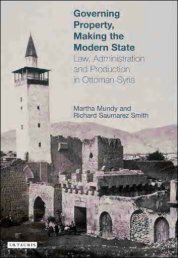The Invention of Tradition as Public Image in the Late ... - PSI424
The Invention of Tradition as Public Image in the Late ... - PSI424
The Invention of Tradition as Public Image in the Late ... - PSI424
Create successful ePaper yourself
Turn your PDF publications into a flip-book with our unique Google optimized e-Paper software.
INVENTING TRADITION AS PUBLIC IMAGE 5<br />
<strong>The</strong> developments <strong>in</strong> <strong>the</strong> Ottoman Empire clearly parallel similar trends <strong>in</strong><br />
o<strong>the</strong>r imperial systems. Anderson accurately po<strong>in</strong>ts to <strong>the</strong> phenomenon <strong>of</strong><br />
"Russification" and "<strong>of</strong>ficial nationalism," <strong>the</strong> policies <strong>of</strong> standardization<br />
and uniformity pursued through education and attempted imposition <strong>of</strong> <strong>the</strong><br />
imperial language on <strong>the</strong> subject peoples.11 This concept <strong>of</strong> national monarchy<br />
w<strong>as</strong> precisely what <strong>the</strong> Ottoman rul<strong>in</strong>g elite w<strong>as</strong> aim<strong>in</strong>g for with its<br />
policy <strong>of</strong> Ottomanism, a concept meant to unite all peoples liv<strong>in</strong>g <strong>in</strong> Ottoman<br />
doma<strong>in</strong>s, Muslim and non-Muslim, Turkish and Greek, Armenian and Jewish,<br />
Kurd and Arab. As such, it w<strong>as</strong> a f<strong>in</strong>e example <strong>of</strong> Anderson's def<strong>in</strong>ition<br />
<strong>of</strong> <strong>of</strong>ficial nationalism because it w<strong>as</strong> "an anticipatory strategy adopted by<br />
dom<strong>in</strong>ant groups who are threatened with marg<strong>in</strong>alization or exclusion from<br />
an emerg<strong>in</strong>g nationally imag<strong>in</strong>ed community."'2 This policy began with <strong>the</strong><br />
Imperial Rescript <strong>of</strong> <strong>the</strong> Rose Chamber <strong>of</strong> 1839 (Hat-i Serif-i Giilhane),<br />
which declared <strong>the</strong> equality before <strong>the</strong> law <strong>of</strong> all Ottomans, Muslim and non-<br />
Muslim. <strong>The</strong> Ottomanism <strong>of</strong> Abdulhamid II (r. 1876-1909) took on a much<br />
more Islamic character, although it did not reverse many <strong>of</strong> <strong>the</strong> adm<strong>in</strong>istrative<br />
trends <strong>of</strong> <strong>the</strong> Tanzimat reforms. <strong>The</strong> concept <strong>of</strong> national monarchy w<strong>as</strong> very<br />
much beh<strong>in</strong>d Abdiilhamid's Islamism. Although it is unclear how much <strong>of</strong> his<br />
decision mak<strong>in</strong>g w<strong>as</strong> <strong>in</strong>formed by Turkism (he did declare on numerous<br />
occ<strong>as</strong>ions that <strong>the</strong> language <strong>of</strong> state w<strong>as</strong> Turkish, yet he promoted Arabs to<br />
unprecedented heights <strong>in</strong> <strong>the</strong> bureaucracy), his brand <strong>of</strong> Ottomanism w<strong>as</strong><br />
def<strong>in</strong>itely an <strong>in</strong>tegrationist policy b<strong>as</strong>ed on Islam, but an Islam which w<strong>as</strong><br />
becom<strong>in</strong>g less and less ecumenical. What w<strong>as</strong> happen<strong>in</strong>g, however, w<strong>as</strong> very<br />
much what Anderson refers to <strong>as</strong> "stretch<strong>in</strong>g <strong>the</strong> short tight sk<strong>in</strong> <strong>of</strong> <strong>the</strong> nation<br />
over <strong>the</strong> gigantic body <strong>of</strong> <strong>the</strong> empire." 3 This w<strong>as</strong> to be taken to its ultimate<br />
extent by <strong>the</strong> Young Turks, but its ideological ancestry w<strong>as</strong> found <strong>in</strong> <strong>the</strong><br />
Hamidian era, although <strong>the</strong> two epochs are usually taken to be antipodal. In<br />
<strong>the</strong> Russian, Ottoman, and Austrian c<strong>as</strong>es, <strong>of</strong>ficial nationalism meant that <strong>the</strong><br />
person <strong>of</strong> <strong>the</strong> monarch came to be directly identified with state power, but this<br />
also had its risks because now <strong>the</strong> monarch became directly responsible for <strong>the</strong><br />
failures <strong>of</strong> <strong>the</strong> system. This is what happened to <strong>the</strong> houses <strong>of</strong> <strong>the</strong> Romanovs,<br />
Hohenzollems, Habsburgs, and <strong>the</strong> Ottomans, which literally came tumbl<strong>in</strong>g<br />
down to human scale. <strong>The</strong> Ottoman Caliphate w<strong>as</strong> abolished by someth<strong>in</strong>g <strong>as</strong><br />
banal <strong>as</strong> an act <strong>of</strong> parliament <strong>in</strong> 1924, largely because what w<strong>as</strong> left <strong>of</strong> its<br />
mystique had been carried away by defeat <strong>in</strong> <strong>the</strong> Great War.<br />
In this article I suggest that <strong>the</strong> evidence <strong>in</strong>dicates that one derives <strong>the</strong><br />
impression that Ottoman nationality w<strong>as</strong> beg<strong>in</strong>n<strong>in</strong>g to be envisioned <strong>in</strong> more<br />
and more secular terms despite <strong>the</strong> religious language <strong>in</strong> which it w<strong>as</strong><br />
couched. In o<strong>the</strong>r words, although <strong>the</strong> state spoke <strong>the</strong> political language <strong>of</strong><br />
11 Anderson, Imag<strong>in</strong>ed Communities, 82-103.<br />
12 Ibid., 82.<br />
13 Ibid., 87.<br />
This content downloaded from 194.27.149.45 on Wed, 15 May 2013 04:39:11 AM<br />
All use subject to JSTOR Terms and Conditions












